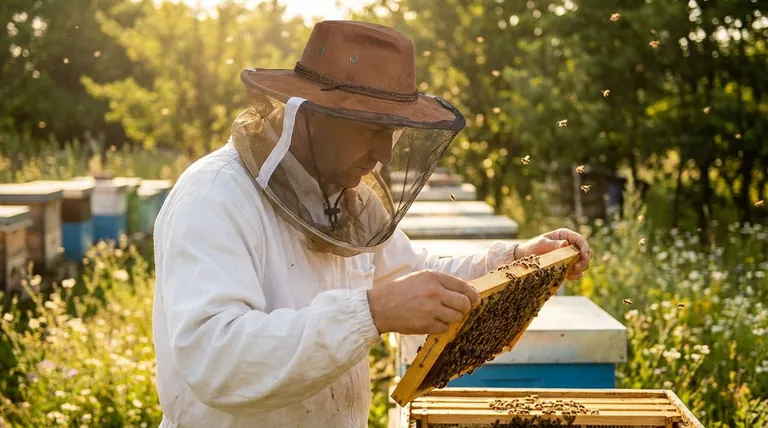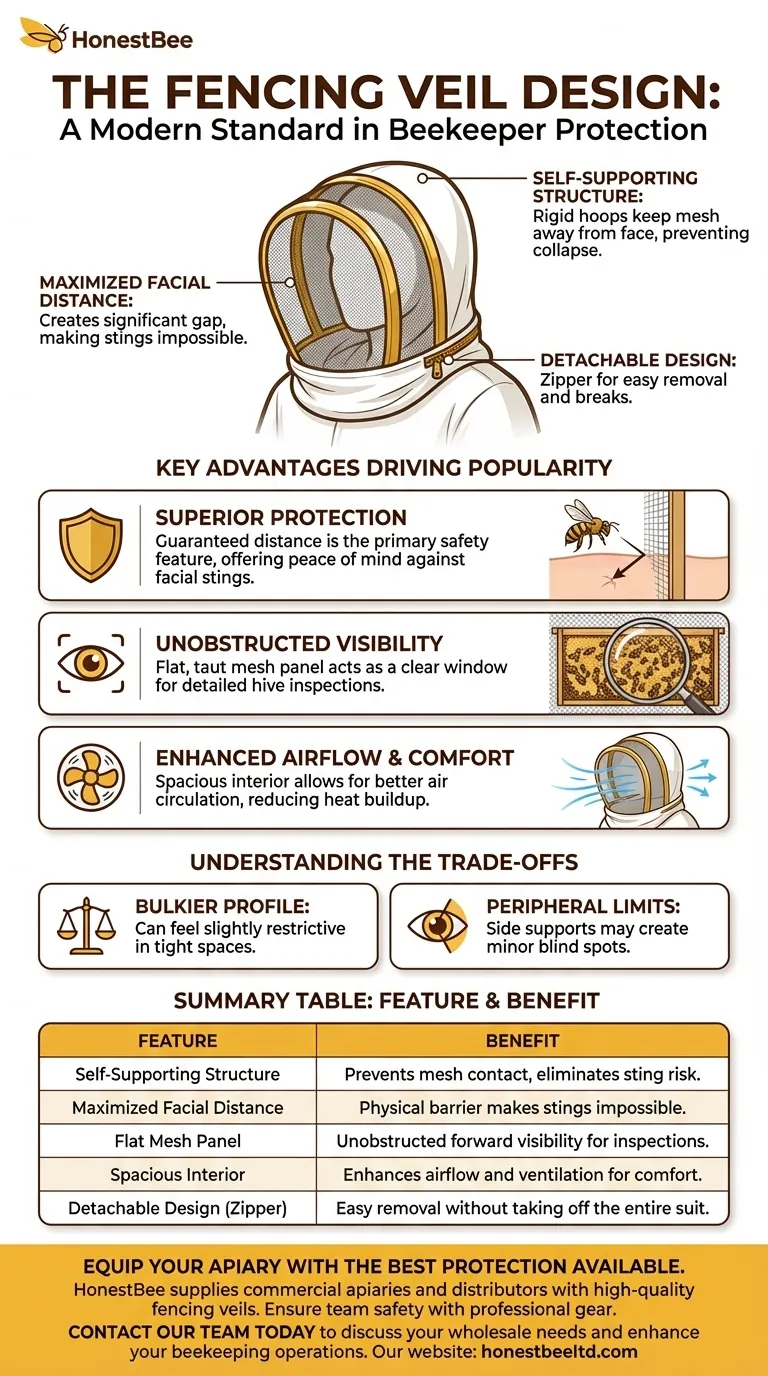The fencing veil design is a type of beekeeper's head protection structured to hold the mesh screen away from the face, closely resembling a fencer's mask. Its immense popularity comes from a superior blend of protection, visibility, and comfort that directly addresses the shortcomings of older designs. By creating a rigid space around the head, it prevents the mesh from touching the skin, which is the primary way bees sting through a veil.
The fencing veil's core advantage is its self-supporting structure. This design solves the main flaws of traditional veils by maximizing the space between the mesh and your face, which directly improves safety, visibility, and ventilation.

The Anatomy of the Design
The effectiveness of the fencing veil lies in its specific structural elements, which set it apart from traditional round veils. Understanding its construction makes its benefits clear.
A Self-Supporting Structure
Unlike a round veil that drapes from the brim of a hat, the fencing veil uses integrated hoops or supports. These elements give the veil its distinct, rigid shape, ensuring it stands on its own.
This structure means the veil doesn't collapse or get blown against your face by the wind, maintaining a consistent protective barrier at all times.
Maximized Facial Distance
The primary function of the structure is to create and maintain a significant gap between the mesh screen and your skin. A bee's stinger is only a few millimeters long, so this distance makes it physically impossible for a bee on the outside of the veil to sting you.
Detachable and Versatile
Most modern fencing veils are attached to the beekeeping suit or jacket with a zipper. This detachable design allows for easy removal when taking a break, drinking water, or driving between apiaries without having to take off the entire suit.
Key Advantages Driving Its Popularity
The fencing veil's design isn't just a stylistic choice; it delivers tangible benefits that enhance both the safety and experience of beekeeping.
Superior Protection
The guaranteed distance from the face is the veil's single most important safety feature. For beginners who are often more nervous, and for experts working with aggressive colonies, this provides critical peace of mind and protection against facial stings.
Unobstructed Visibility
The front of the veil typically features a flat, taut panel of mesh. This acts like a clear window, providing excellent forward vision, which is crucial for detailed tasks like inspecting brood frames for eggs and larvae. It avoids the visual distortion that can occur with the bunched or draped mesh of a round veil.
Enhanced Airflow and Comfort
The spacious interior created by the veil’s structure allows for significantly better air circulation around the head and neck. This ventilation is a major factor in beekeeper comfort, reducing heat buildup and making long inspections on hot days far more tolerable.
Understanding the Trade-offs
While highly popular, the fencing veil is not without its considerations. Objectively evaluating its design means acknowledging its potential downsides compared to other styles.
A Slightly Bulkier Profile
The rigid structure, while protective, can feel bulkier than a simple round veil. This can be noticeable when turning your head quickly or working in very tight spaces.
Peripheral Vision Limitations
While forward visibility is excellent, the side supports of the veil can sometimes create minor blind spots. A traditional round veil, with its wide, continuous brim, can occasionally offer a slightly better peripheral field of view.
Making the Right Choice for Your Needs
Selecting a veil design depends entirely on your priorities as a beekeeper.
- If your primary focus is maximum safety and clear forward visibility: The fencing veil is the definitive choice, especially for beginners who want to minimize all risk of facial stings.
- If you work long hours in hot climates: The superior airflow of the fencing veil makes it the most comfortable and practical option for extended hive inspections.
- If your primary focus is absolute simplicity and minimal bulk: A traditional round veil can be effective, but you must remain constantly aware to ensure the mesh does not make contact with your skin.
Ultimately, the fencing veil's design represents a significant and practical evolution in beekeeper safety and comfort.
Summary Table:
| Feature | Benefit |
|---|---|
| Self-Supporting Structure | Prevents mesh from touching the face, eliminating risk of stings. |
| Maximized Facial Distance | Creates a physical barrier, making it impossible for bees to sting through. |
| Flat Mesh Panel | Provides unobstructed forward visibility for detailed hive inspections. |
| Spacious Interior | Enhances airflow and ventilation, increasing comfort on hot days. |
| Detachable Design (Zipper) | Allows for easy removal without taking off the entire suit. |
Equip your apiary with the best protection available. The fencing veil's superior design is a cornerstone of modern beekeeping safety and efficiency. At HONESTBEE, we supply commercial apiaries and beekeeping equipment distributors with high-quality, durable fencing veils and other essential gear through our wholesale-focused operations. Ensure your team's safety and comfort with equipment built for professionals. Contact our team today to discuss your wholesale needs and enhance your beekeeping operations.
Visual Guide

Related Products
- Heavy Duty Cowboy Beekeeper Hat with Visibility Veil Outdoor Professional Beekeeping Protective Gear
- Cotton Beekeeping Suit and Round Hat with Veil Bee Keeper Protective Gear
- Square Folding Bee Hat Veil with String for Beekeeping
- Beekeeper Cowboy Hat and Veil for Beekeeping
- Yellow Plastic Bucket Pail Perch for Beekeeping
People Also Ask
- What features enhance the quality of the beekeeping veil? Choose the Right Protection for Your Apiary
- How does the design of the beekeeping hat ensure comfort during extended use? Maximize Comfort for Long Apiary Hours
- What is the purpose of the high visibility veil on the beekeeping hat? Ensure Maximum Safety and Clarity
- How should the beekeeping hat veil be cleaned? The Only Safe Method to Preserve Protection
- What are the benefits of the lightweight fabric used in the beekeeping hat veil? Enhanced Visibility & Comfort for Hive Work



















